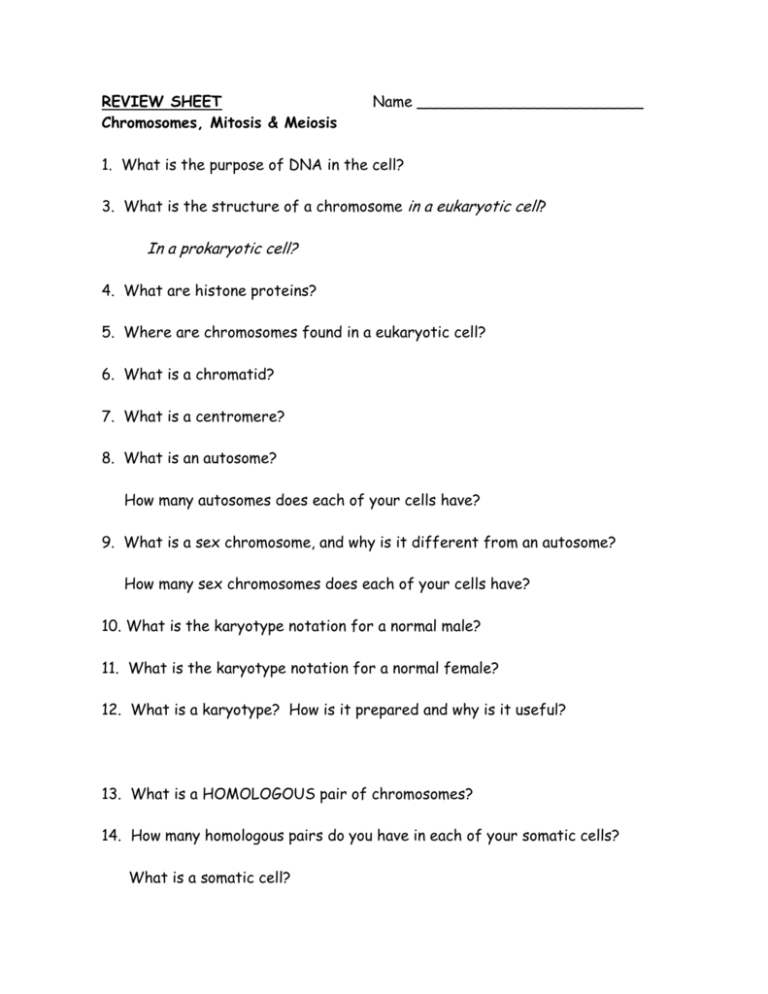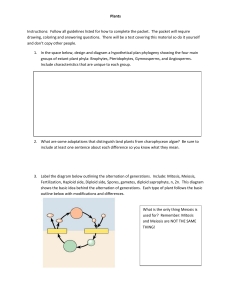Review Sheet Cell Division Chromosomes
advertisement

REVIEW SHEET Chromosomes, Mitosis & Meiosis Name ________________________ 1. What is the purpose of DNA in the cell? 3. What is the structure of a chromosome in a eukaryotic cell? In a prokaryotic cell? 4. What are histone proteins? 5. Where are chromosomes found in a eukaryotic cell? 6. What is a chromatid? 7. What is a centromere? 8. What is an autosome? How many autosomes does each of your cells have? 9. What is a sex chromosome, and why is it different from an autosome? How many sex chromosomes does each of your cells have? 10. What is the karyotype notation for a normal male? 11. What is the karyotype notation for a normal female? 12. What is a karyotype? How is it prepared and why is it useful? 13. What is a HOMOLOGOUS pair of chromosomes? 14. How many homologous pairs do you have in each of your somatic cells? What is a somatic cell? 15. What does DIPLOID mean? How is it abbreviated? What type of cell is diploid? 16. What does HAPLOID mean? How is it abbreviated? What type of cell is haploid? 17. Describe binary fission? What type of organism uses binary fission? 18. In terms of structure, what is the major difference between a prokaryote and a eukaryote? 19. Mitosis occurs in what type of cells (somatic or sex cells)? 20. Meiosis occurs in what type of cells (somatic or sex cells)? 21. When does INTERPHASE occur in the cell? Name the three phases of interphase and briefly describe each: 1. 2. 3. 22. What does MITOSIS divide? 23. What does CYTOKINESIS divide? 24. What is CHROMATIN? 25. What is the purpose of the SPINDLE in mitosis? STUDY THE MITOSIS & MEIOSIS DIAGRAMS IN YOUR FOLDER! 26. 27. What type of cell forms a cleavage furrow (plant or animal cell)? 28. What type of cell forms a cell plate (plant or animal cell)? 29. In what stage of cell division do the organelles from the original cell divide between the two newly formed cells? 30. Compare the resulting cells of mitosis to the resulting cells of meiosis Cells after mitosis – haploid or diploid (circle one) Cells after meiosis - haploid or diploid (circle one) 31. What is a gamete? 32. Does interphase occur before meiosis I begins? 32. Does interphase occur between meiosis I and meiosis II? 33. What is the ploidy of a cell (haploid or diploid) when it begins meiosis I? 34. How many cells are formed during meiosis I? 35. What is the ploidy of a cell when it begins meiosis II (haploid or diploid)? 36. How many cells are formed during meiosis II? 37. What is the ploidy of a cell after it completes meiosis II (haploid or diploid)? 38. In the circles below, draw a cell as it would look in that particular stage, if the 2n chromosome number would be 4. Then, circle whether the cell is haploid or diploid in that particular stage. Diploid cell = 4 chromosomes Metaphase During Mitosis Metaphase I Metaphase II haploid / diploid haploid / diploid haploid / diploid 39. What is SYNAPSIS and when does it occur? 40. What is CROSSING-OVER and when does it occur? 41. What is INDEPENDENT ASSORTMENT and when does it occur? 42. In which part of the human body does meiosis take place? 43. What is SPERMATOGENESIS? 44. What is OOGENESIS? How many cells total are formed during oogenesis? How many of these cells are EGG cells? What are the other cells called? What is the function of these “other” cells? 45. Compare sexual and asexual reproduction: o o 46. How many parents are required for each? (one or two) Sexual: Asexual: How do the offspring compare to the parents? (different or identical?) Sexual: Asexual: STUDY THE MEIOSIS DIAGRAMS IN YOUR NOTEBOOK. Also study the “cut & paste” meiosis diagram that you made in class.








